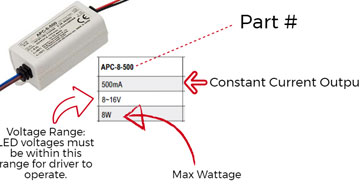constant voltage driver current driver
2019-03-07 17:30:51
constant voltage driver constant current driver
Constant Current vs. Constant Voltage
Constant current and Constant voltage drivers are both viable options for a power supply for LED light sources, what differs is the way in which they deliver the power. LED drivers are the driving force that provides and regulates the necessary power to make sure the LEDs operate in a safe and consistent manner. Understanding the difference between the two types can:

1.Aid in properly powering LEDs
2.Avoid serious damages to your LED investment
What is a Constant Current LED Driver?
Constant current LED drivers are designed for a designated range of output voltages and a fixed output current (mA). LEDs that are rated to operate on a constant current driver require a designated supply of current usually specified in milliamps (mA) or amps (A). These drivers vary the voltage along an electronic circuit which allows current to remain constant throughout the LED system.
Higher current ratings do make the LED brighter, but if not regulated, the LED will draw more current than it is rated for. Thermal Runaway refers to excess current beyond the LEDs maximum drive current which results in drastically lower LED life-spans and premature burn outs due to increased temperature. A constant current driver is the best way to drive high power LEDs as it maintains a consistent brightness across all LEDs in-series.
What is a Constant Voltage LED Driver?
Constant voltage drivers are designed for a single direct current (DC) output voltage. Most common constant voltage drivers (or Power Supplies) are 12VDC or 24VDC. An LED light that is rated for constant voltage usually specifies the amount of input voltage it needs to operate correctly.
A constant voltage power supply receives standard line voltage (120-277VAC). This is the type of power that is typically output from your wall outlets around the home. Constant Voltage Drivers switch this alternating current voltage (VAC) to a low direct current voltage (VDC). The driver will always maintain a constant voltage no matter what kind of current load is put on it. An example of a constant voltage power supply is below in the Mean Well LPV-60-12.
When do I use a constant voltage LED driver?
The above example is with high powered LEDs and on a smaller scale as we only talked of using one LED. With lighting in the real world, it isn’t convenient or economical to build everything by hand from a single diode, LEDs are usually used together in series and/or parallel circuits to create the desired outcome. Fortunately for lighting designers, manufacturers have introduced many LED products to the market that have multiple LEDs already assembled together like LED rope light, LED strips, LED bars, etc.
The most common LED strips are designed with a group of LEDs in series with a current-limiting resistor in line with them. The manufacturers make sure the resistors are of the right value and in the right position so that the LEDs on the strips will be less prone to the variation of the voltage source as we talked of with the XP-G2. Since their current is already being regulated, all they need is a constant voltage to power the LED(s).
When LEDs or an array of LEDs are constructed like this they will typically state a voltage to be run at. So if you see that your strip takes 12VDC, don’t worry about a constant current driver, all you will need is a 12VDC constant voltage source as the current is already being regulated by on board circuitry that the manufacturer has built in.
Advantage of using a constant voltage LED driver
You use a constant voltage LED driver only when using an LED or array that has been specified to take a certain voltage. This is helpful as:
1.Constant voltage is a much more familiar technology for the design and installation engineers.
2.The cost of these systems can be lower, especially in larger scale applications.
Feel free to take a look over at our guide to LED strips that has a lot of devices that can be run from constant voltage. Also, if you need help selecting a constant current LED driver, head over to our helpful post on how to choose the right one.






